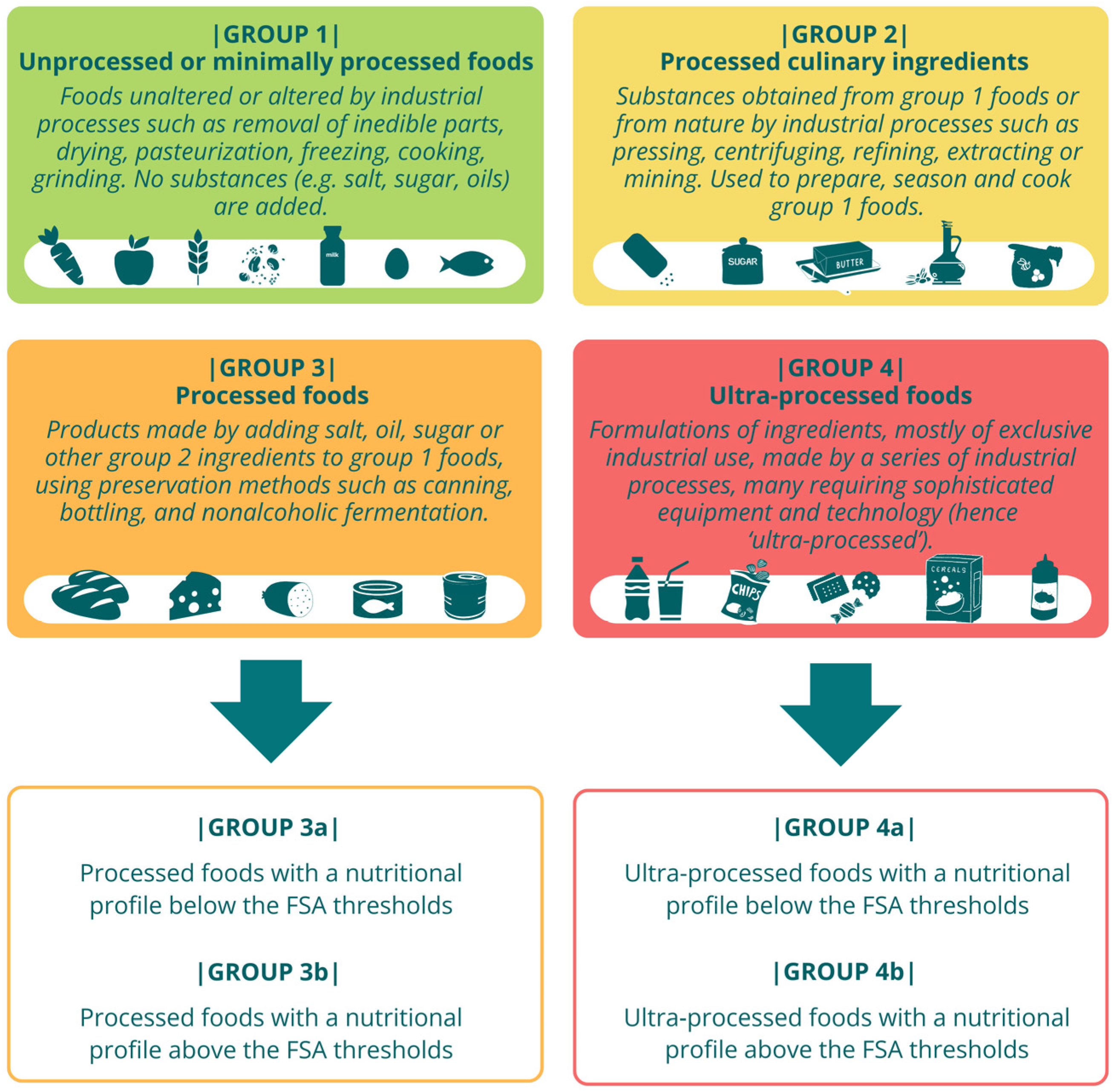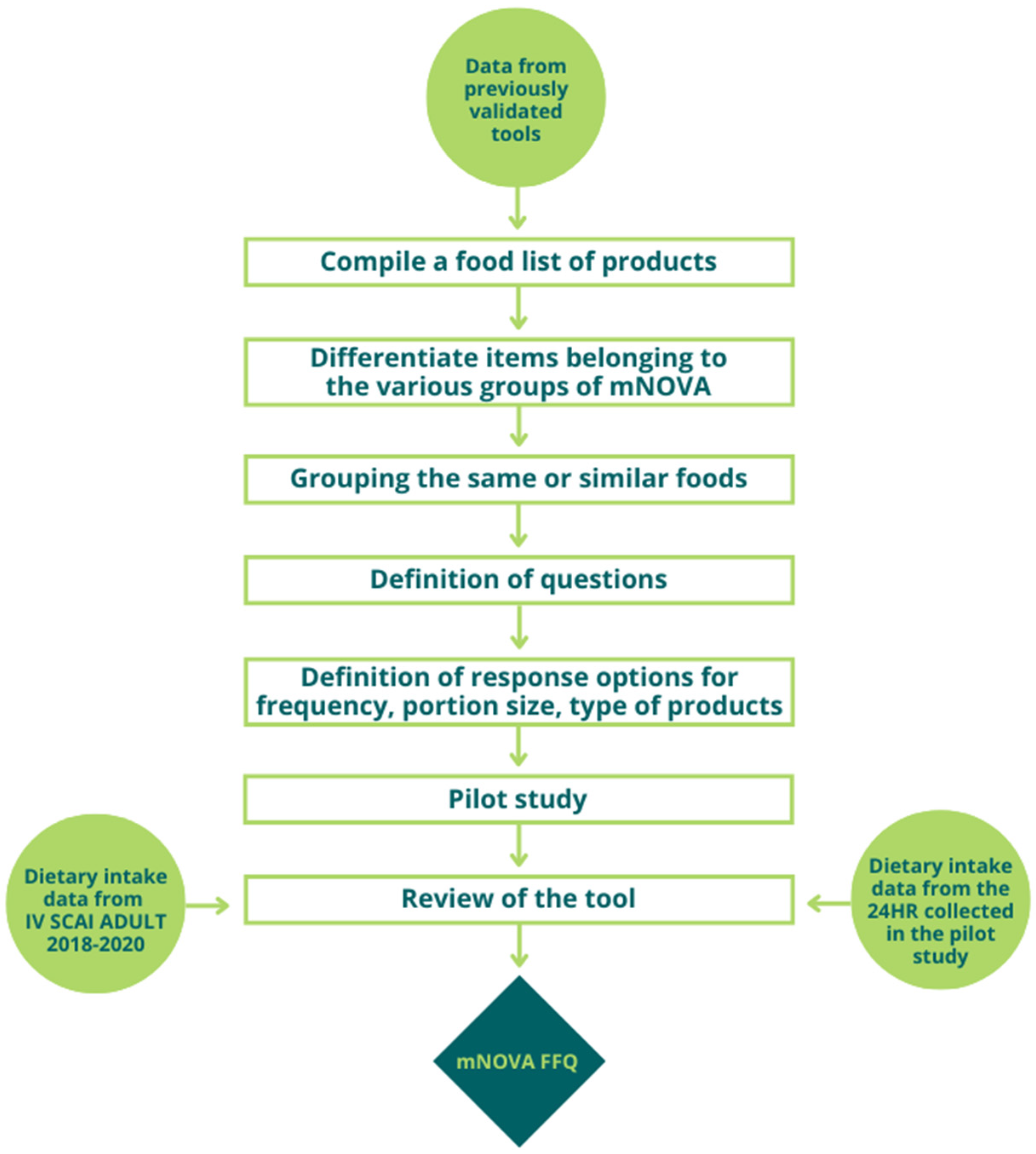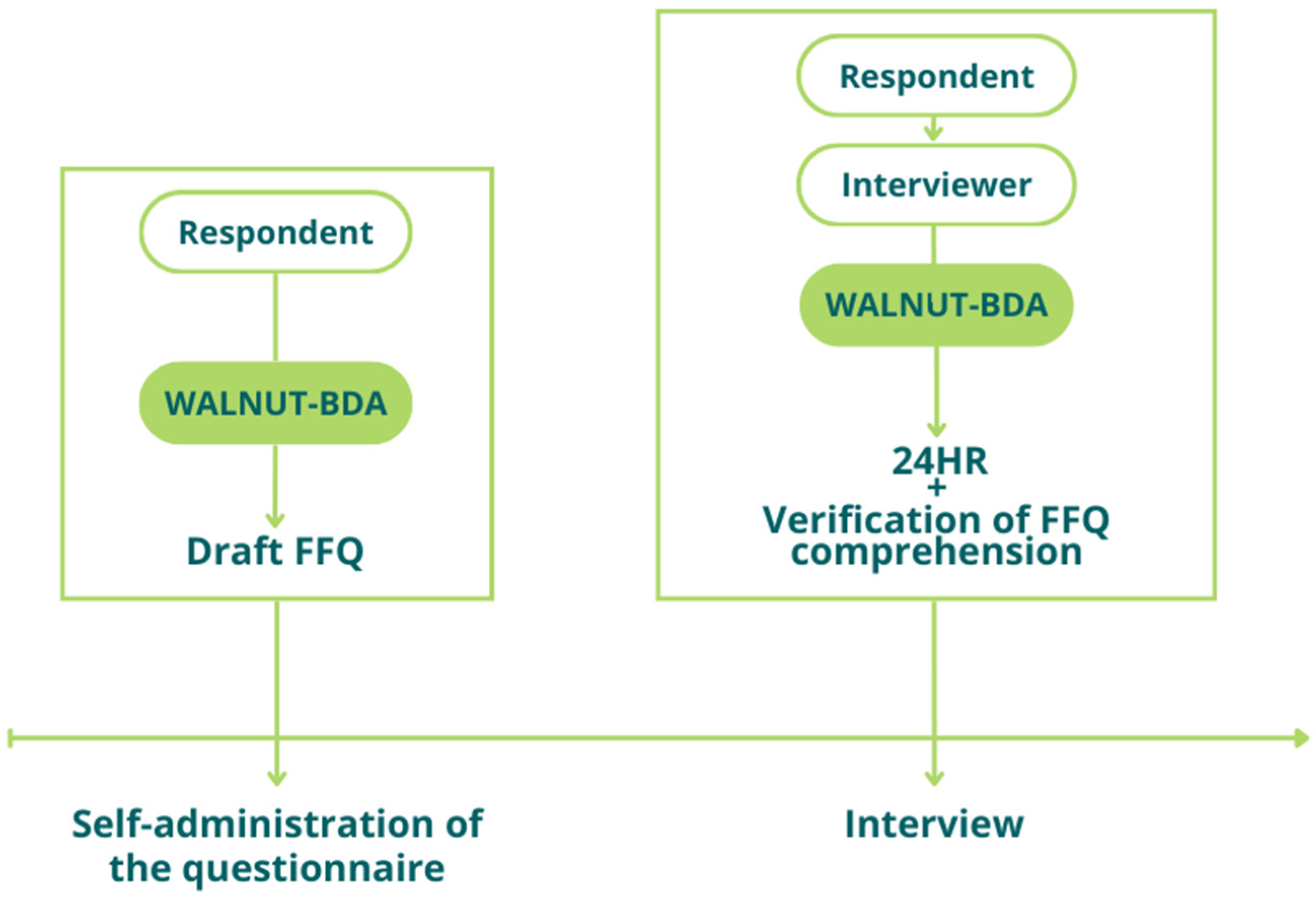The Development of a Food Frequency Questionnaire for the Assessment of Ultra-Processed Food Consumption in the Italian Adult Population: Protocol for a Validity and Reproducibility Study
Abstract
1. Introduction
2. Materials and Methods
2.1. Ethics and Study Design
- A pilot study to evaluate the current food consumption of the target audience and test the face validity of the new FFQ;
- A validation study to test the criterion validity and reproducibility of the new tool.
2.2. Population
2.3. Definition of Modified NOVA Classification
2.4. Questionnaire Development
2.5. Phase 1: Pilot Study
2.6. Phase 2: Validity and Reproducibility
2.7. Statistical Analysis
3. Discussion and Future Perspectives
4. Conclusions
Author Contributions
Funding
Institutional Review Board Statement
Informed Consent Statement
Data Availability Statement
Conflicts of Interest
References
- Rosi, A.; Paolella, G.; Biasini, B.; Scazzina, F.; Alicante, P.; De Blasio, F.; dello Russo, M.; Rendina, D.; Tabacchi, G.; Cairella, G.; et al. Dietary Habits of Adolescents Living in North America, Europe or Oceania: A Review on Fruit, Vegetable and Legume Consumption, Sodium Intake, and Adherence to the Mediterranean Diet. Nutr. Metab. Cardiovasc. Dis. 2019, 29, 544–560. [Google Scholar] [CrossRef] [PubMed]
- Germani, A.; Vitiello, V.; Giusti, A.M.; Pinto, A.; Donini, L.M.; Del Balzo, V. Environmental and Economic Sustainability of the Mediterranean Diet. Int. J. Food Sci. Nutr. 2014, 65, 1008–1012. [Google Scholar] [CrossRef] [PubMed]
- Cardamone, E.; Iacoponi, F.; Di Benedetto, R.; Lorenzoni, G.; Di Nucci, A.; Zobec, F.; Gregori, D.; Silano, M. Adherence to Mediterranean Diet and Its Main Determinants in a Sample of Italian Adults: Results from the ARIANNA Cross-Sectional Survey. Front. Nutr. 2024, 11, 1346455. [Google Scholar] [CrossRef]
- Dernini, S.; Berry, E.M. Mediterranean Diet: From a Healthy Diet to a Sustainable Dietary Pattern. Front. Nutr. 2015, 2, 15. [Google Scholar] [CrossRef]
- Belahsen, R. Nutrition Transition and Food Sustainability. Proc. Nutr. Soc. 2014, 73, 385–388. [Google Scholar] [CrossRef]
- Clemente-Suárez, V.J.; Beltrán-Velasco, A.I.; Redondo-Flórez, L.; Martín-Rodríguez, A.; Tornero-Aguilera, J.F. Global Impacts of Western Diet and Its Effects on Metabolism and Health: A Narrative Review. Nutrients 2023, 15, 2749. [Google Scholar] [CrossRef] [PubMed]
- Medina-Remón, A.; Kirwan, R.; Lamuela-Raventós, R.M.; Estruch, R. Dietary Patterns and the Risk of Obesity, Type 2 Diabetes Mellitus, Cardiovascular Diseases, Asthma, and Neurodegenerative Diseases. Crit. Rev. Food Sci. Nutr. 2018, 58, 262–296. [Google Scholar] [CrossRef]
- Italian National Institute of Health Surveillance and Registers. EpiCentro-Epidemiology for Public Health. Available online: https://www.epicentro.iss.it/en/index/surveillance-registry (accessed on 15 October 2024).
- Lorenzoni, G.; Di Benedetto, R.; Silano, M.; Gregori, D. What Is the Nutritional Composition of Ultra-Processed Food Marketed in Italy? Nutrients 2021, 13, 2364. [Google Scholar] [CrossRef]
- SACN Statement on Processed Foods and Health-GOV.UK. Available online: https://www.gov.uk/government/publications/sacn-statement-on-processed-foods-and-health (accessed on 15 October 2024).
- Sadler, C.R.; Grassby, T.; Hart, K.; Raats, M.; Sokolović, M.; Timotijevic, L. Processed Food Classification: Conceptualisation and Challenges. Trends Food Sci. Technol. 2021, 112, 149–162. [Google Scholar] [CrossRef]
- Monteiro, C.A. Nutrition and Health. The Issue Is Not Food, nor Nutrients, so Much as Processing. Public Health Nutr. 2009, 12, 729–731. [Google Scholar] [CrossRef]
- Monteiro, C.A.; Cannon, G.; Moubarac, J.C.; Levy, R.B.; Louzada, M.L.C.; Jaime, P.C. The UN Decade of Nutrition, the NOVA Food Classification and the Trouble with Ultra-Processing. Public Health Nutr. 2018, 21, 5–17. [Google Scholar] [CrossRef] [PubMed]
- Monteiro, C.A.; Cannon, G.; Lawrence, M.; Costa Louzada, M.L.; Pereira Machado, P. Ultra-Processed Foods, Diet Quality, and Health Using the NOVA Classification System, 1st ed.; FAO: Rome, Italy, 2019. [Google Scholar]
- Pagliai, G.; Dinu, M.; Madarena, M.P.; Bonaccio, M.; Iacoviello, L.; Sofi, F. Consumption of Ultra-Processed Foods and Health Status: A Systematic Review and Meta-Analysis. Br. J. Nutr. 2021, 125, 308–318. [Google Scholar] [CrossRef]
- Cordova, R.; Viallon, V.; Fontvieille, E.; Peruchet-Noray, L.; Jansana, A.; Wagner, K.H.; Kyrø, C.; Tjønneland, A.; Katzke, V.; Bajracharya, R.; et al. Consumption of Ultra-Processed Foods and Risk of Multimorbidity of Cancer and Cardiometabolic Diseases: A Multinational Cohort Study. Lancet Reg. Health Eur. 2023, 35, 100771. [Google Scholar] [CrossRef] [PubMed]
- Marconi, E.; Capozzi, F.; Casiraghi, E.; Cotroneo, R.; Danieli, P.P.; De Arcangelis, E.; De Tata, V.; Fantozzi, P.; Martini, D.; Menchise, C.; et al. Position Paper “ULTRAPROCESSED FOODS PRO & CONS”. 2023. Available online: https://clusteragrifood.it/wp-content/uploads/2023/12/POSITION-PAPER-CLAN_ULTRA-PROCESSED-FOOD.pdf (accessed on 15 October 2024).
- Dinu, M.; Bonaccio, M.; Martini, D.; Madarena, M.P.; Vitale, M.; Pagliai, G.; Esposito, S.; Ferraris, C.; Guglielmetti, M.; Rosi, A.; et al. Reproducibility and Validity of a Food-Frequency Questionnaire (NFFQ) to Assess Food Consumption Based on the NOVA Classification in Adults. Int. J. Food Sci. Nutr. 2021, 72, 861–869. [Google Scholar] [CrossRef]
- Willett, W. Nutritional Epidemiology, 3rd ed.; Oxford University Press: Oxford, UK, 2012. [Google Scholar]
- Decarli, A.; Franceschi, S.; Ferraroni, M.; Gnagnarella, P.; Parpinel, M.T.; La Vecchia, C.; Negri, E.; Salvini, S.; Falcini, F.; Giacosa, A. Validation of a Food-Frequency Questionnaire to Assess Dietary Intakes in Cancer Studies in Italy Results for Specific Nutrients. Ann. Epidemiol. 1996, 6, 110–118. [Google Scholar] [CrossRef]
- Masocco, M.; Minardi, V.; Contoli, B.; Minelli, G.; Manno, V.; Cobellis, L.; Greco, D. Sovrappeso e Obesità Nella Popolazione Adulta in Italia: Trend Temporali, Differenze Socio-Anagrafiche e Regionali Con Focus Sulla Regione Campania. Boll. Epidemiol. Naz. 2023, 4, 1–8. [Google Scholar] [CrossRef]
- Braesco, V.; Souchon, I.; Sauvant, P.; Haurogné, T.; Maillot, M.; Féart, C.; Darmon, N. Ultra-Processed Foods: How Functional Is the NOVA System? Eur. J. Clin. Nutr. 2022, 76, 1245–1253. [Google Scholar] [CrossRef] [PubMed]
- Dickie, S.; Woods, J.; Machado, P.; Lawrence, M. A Novel Food Processing-Based Nutrition Classification Scheme for Guiding Policy Actions Applied to the Australian Food Supply. Front. Nutr. 2023, 10, 1071356. [Google Scholar] [CrossRef]
- Phulkerd, S.; Dickie, S.; Thongcharoenchupong, N.; Thapsuwan, S.; Machado, P.; Woods, J.; Mo-Suwan, L.; Prasertsom, P.; Ungchusak, C.; Khitdee, C.; et al. Choosing an Effective Food Classification System for Promoting Healthy Diets in Thailand: A Comparative Evaluation of Three Nutrient Profiling-Based Food Classification Systems (Government, WHO, and Healthier Choice Logo) and a Food-Processing-Based Food Classification System (NOVA). Front. Nutr. 2023, 10, 1149813. [Google Scholar] [CrossRef]
- Popkin, B.M.; Miles, D.R.; Taillie, L.S.; Dunford, E.K. A Policy Approach to Identifying Food and Beverage Products That Are Ultra-Processed and High in Added Salt, Sugar and Saturated Fat in the United States: A Cross-Sectional Analysis of Packaged Foods. Lancet Reg. Health Am. 2024, 32, 100713. [Google Scholar] [CrossRef]
- Davidou, S.; Christodoulou, A.; Fardet, A.; Frank, K. The Holistico-Reductionist Siga Classification According to the Degree of Food Processing: An Evaluation of Ultra-Processed Foods in French Supermarkets. Food Funct. 2020, 11, 2026–2039. [Google Scholar] [CrossRef] [PubMed]
- Uk Department of Health, Food Standard Agency, Devolved Administrations in Scotland, Northern Ireland and Wales, British Retail Consortium. Guide to Creating a Front of Pack (FoP) Nutrition Label for Pre-Packed Products Sold through Retail Outlets. 2016. Available online: https://www.food.gov.uk/sites/default/files/media/document/fop-guidance_0.pdf (accessed on 15 October 2024).
- Buscemi, S.; Rosafio, G.; Vasto, S.; Massenti, F.M.; Grosso, G.; Galvano, F.; Rini, N.; Barile, A.M.; Maniaci, V.; Cosentino, L.; et al. Validation of a Food Frequency Questionnaire for Use in Italian Adults Living in Sicily. Int. J. Food Sci. Nutr. 2015, 66, 426–438. [Google Scholar] [CrossRef] [PubMed]
- EFSA. Food Consumption Data. Available online: https://www.efsa.europa.eu/en/data-report/food-consumption-data (accessed on 16 October 2024).
- Wiering, B.; de Boer, D.; Delnoij, D. Patient Involvement in the Development of Patient-Reported Outcome Measures: A Scoping Review. Health Expect 2017, 20, 11–23. [Google Scholar] [CrossRef] [PubMed]
- Fatihah, F.; Ng, B.K.; Hazwanie, H.; Karim Norimah, A.; Shanita, S.N.; Ruzita, A.T.; Poh, B.K. Development and Validation of a Food Frequency Questionnaire for Dietary Intake Assessment among Multi-Ethnic Primary School-Aged Children. Singap. Med. J. 2015, 56, 687. [Google Scholar] [CrossRef]
- Gnagnarella, P.; Salvini, S.; Parpinel, M. Food Composition Database for Epidemiological Studies in Italy. Available online: https://bda.ieo.it/ (accessed on 16 October 2024).
- Costa, C.D.S.; Faria, F.R.; Gabe, K.T.; Sattamini, I.F.; Khandpur, N.; Leite, F.H.M.; Steele, E.M.; Louzada, M.L.D.C.; Levy, R.B.; Monteiro, C.A. Nova Score for the Consumption of Ultra-Processed Foods: Description and Performance Evaluation in Brazil. Rev. Saude Publica 2021, 55, 13. [Google Scholar] [CrossRef]
- Kébé, S.D.; Diouf, A.; Sylla, P.M.D.D.; Kane, K.; dos Santos Costa, C.; Leite, F.H.M.; Andrade, G.C.; Badiane, A.; Moubarac, J.C.; Idohou-Dossou, N.; et al. Assessment of Ultra Processed Foods Consumption in Senegal: Validation of the Nova-UPF Screener. Arch. Public Health 2024, 82, 4. [Google Scholar] [CrossRef]
- Neri, D.; Gabe, K.T.; Costa, C.D.S.; Martinez Steele, E.; Rauber, F.; Marchioni, D.M.; Da Costa Louzada, M.L.; Levy, R.B.; Monteiro, C.A. A Novel Web-Based 24-h Dietary Recall Tool in Line with the Nova Food Processing Classification: Description and Evaluation. Public Health Nutr. 2023, 26, 1997. [Google Scholar] [CrossRef]
- Frade, E.O.d.S.; Gabe, K.T.; Costa, C.d.S.; Neri, D.; Steele, E.M.; Rauber, F.; Steluti, J.; Levy, R.B.; Louzada, M.L.d.C. A Novel Food Frequency Questionnaire for Brazilian Adults Based on the Nova Classification System: Development, Reproducibility and Validation. medRxiv 2024. medRxiv:2024.04.19.24305963. [Google Scholar] [CrossRef]
- Sarbagili-Shabat, C.; Zelber-Sagi, S.; Fliss Isakov, N.; Ron, Y.; Hirsch, A.; Maharshak, N. Development and Validation of Processed Foods Questionnaire (PFQ) in Adult Inflammatory Bowel Diseases Patients. Eur. J. Clin. Nutr. 2020, 74, 1653–1660. [Google Scholar] [CrossRef]
- Fangupo, L.J.; Haszard, J.J.; Leong, C.; Heath, A.L.M.; Fleming, E.A.; Taylor, R.W. Relative Validity and Reproducibility of a Food Frequency Questionnaire to Assess Energy Intake from Minimally Processed and Ultra-Processed Foods in Young Children. Nutrients 2019, 11, 1290. [Google Scholar] [CrossRef]
- Chen, Z.; Khandpur, N.; Desjardins, C.; Wang, L.; Monteiro, C.A.; Rossato, S.L.; Fung, T.T.; Manson, J.E.; Willett, W.C.; Rimm, E.B.; et al. Ultra-Processed Food Consumption and Risk of Type 2 Diabetes: Three Large Prospective U.S. Cohort Studies. Diabetes Care 2023, 46, 1335–1344. [Google Scholar] [CrossRef] [PubMed]
- Mendoza, K.; Smith-Warner, S.A.; Rossato, S.L.; Khandpur, N.; Manson, J.A.E.; Qi, L.; Rimm, E.B.; Mukamal, K.J.; Willett, W.C.; Wang, M.; et al. Ultra-Processed Foods and Cardiovascular Disease: Analysis of Three Large US Prospective Cohorts and a Systematic Review and Meta-Analysis of Prospective Cohort Studies. Lancet Reg. Health Am. 2024, 37, 100859. [Google Scholar] [CrossRef] [PubMed]
- Dicken, S.J.; Dahm, C.C.; Ibsen, D.B.; Olsen, A.; Tjønneland, A.; Louati-Hajji, M.; Cadeau, C.; Marques, C.; Schulze, M.B.; Jannasch, F.; et al. Food Consumption by Degree of Food Processing and Risk of Type 2 Diabetes Mellitus: A Prospective Cohort Analysis of the European Prospective Investigation into Cancer and Nutrition (EPIC). Lancet Reg. Health Eur. 2024, 46, 101043. [Google Scholar] [CrossRef] [PubMed]
- Gibson, R.S. Principles of Nutritional Assessment, 2nd ed.; Oxford University Press: New York, NY, USA, 2005. [Google Scholar]
- Meade, A.W.; Craig, S.B. Identifying Careless Responses in Survey Data. Psychol. Methods 2012, 17, 437–455. [Google Scholar] [CrossRef]




Disclaimer/Publisher’s Note: The statements, opinions and data contained in all publications are solely those of the individual author(s) and contributor(s) and not of MDPI and/or the editor(s). MDPI and/or the editor(s) disclaim responsibility for any injury to people or property resulting from any ideas, methods, instructions or products referred to in the content. |
© 2024 by the authors. Licensee MDPI, Basel, Switzerland. This article is an open access article distributed under the terms and conditions of the Creative Commons Attribution (CC BY) license (https://creativecommons.org/licenses/by/4.0/).
Share and Cite
Cardamone, E.; Iacoponi, F.; Fiori, F.; Marinoni, M.; Agrimi, U.; Silano, M.; Parpinel, M. The Development of a Food Frequency Questionnaire for the Assessment of Ultra-Processed Food Consumption in the Italian Adult Population: Protocol for a Validity and Reproducibility Study. Nutrients 2024, 16, 3896. https://doi.org/10.3390/nu16223896
Cardamone E, Iacoponi F, Fiori F, Marinoni M, Agrimi U, Silano M, Parpinel M. The Development of a Food Frequency Questionnaire for the Assessment of Ultra-Processed Food Consumption in the Italian Adult Population: Protocol for a Validity and Reproducibility Study. Nutrients. 2024; 16(22):3896. https://doi.org/10.3390/nu16223896
Chicago/Turabian StyleCardamone, Erica, Francesca Iacoponi, Federica Fiori, Michela Marinoni, Umberto Agrimi, Marco Silano, and Maria Parpinel. 2024. "The Development of a Food Frequency Questionnaire for the Assessment of Ultra-Processed Food Consumption in the Italian Adult Population: Protocol for a Validity and Reproducibility Study" Nutrients 16, no. 22: 3896. https://doi.org/10.3390/nu16223896
APA StyleCardamone, E., Iacoponi, F., Fiori, F., Marinoni, M., Agrimi, U., Silano, M., & Parpinel, M. (2024). The Development of a Food Frequency Questionnaire for the Assessment of Ultra-Processed Food Consumption in the Italian Adult Population: Protocol for a Validity and Reproducibility Study. Nutrients, 16(22), 3896. https://doi.org/10.3390/nu16223896






